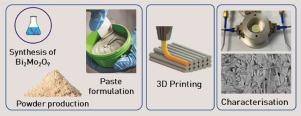Applied Materials Today ( IF 7.2 ) Pub Date : 2020-10-24 , DOI: 10.1016/j.apmt.2020.100862 Athanasios Goulas , George Chi-Tangyie , Dawei Wang , Shiyu Zhang , Annapoorani Ketharam , Bala Vaidhyanathan , Ian M. Reaney , Darren A. Cadman , Will G. Whittow , John (Yiannis) C. Vardaxoglou , Daniel S. Engstrøm

|
Low sintering temperature, ultra-low loss microwave ceramics are envisaged as future dielectrics for fabricating low temperature co-fired ceramic (LTCC) components for 5G applications. Low sintering temperature bismuth molybdate β-Bi2Mo2O9 ceramic powders have been synthesised using a solid-state reaction method. Their additive manufacture and resulting microwave properties are reported for the first time. Optimum densification occurred for 3D printed samples sintered 4 hours at 670°C which resulted in a maximum relative density (ρr) of 92%, relative permittivity (εr) of 34, dielectric loss (tanδ) of 0.0007, giving a microwave quality factor (Qxf) of 10,050 GHz, properties attractive for LTCC applications.
中文翻译:

用于LTCC应用的3D打印低损耗Bi 2 Mo 2 O 9陶瓷的微观结构和微波介电性能
低烧结温度,超低损耗微波陶瓷被设想为制造5G应用的低温共烧陶瓷(LTCC)组件的未来电介质。烧结温度低的钼酸铋β-Bi系2沫2 ö 9陶瓷粉末已使用固态反应法合成。首次报道了它们的增材制造和由此产生的微波特性。发生最佳的致密化的三维印刷的样品烧结4小时670℃,这导致了最大相对密度(ρ [R的92%,相对介电常数()ε - [R 34),介电损耗(tanδ的0.0007),得到一个微波质量因子(Qxf)为10,050 GHz,对LTCC应用具有吸引力。











































 京公网安备 11010802027423号
京公网安备 11010802027423号